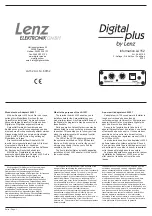
18 Appendix: Electromagnetic Compatibility
The European Union obligates its member states to harmonise their statutory
provisions in respect of electromagnetic compatibility by means of Directive
2004/108/EC. In the following text this Directive is abbreviated to the EMC
Directive.
All electrical and electronic device that is put into circulation in Europe must,
therefore, conform to the fundamental safety requirements of the EMC Direc-
tive. According to this Directive, electromagnetic compatibility is the ability of
a device, plant or system to work satisfactorily in the electromagnetic environ-
ment, without itself causing electromagnetic interference that would be unac-
ceptable to all devices, plant and systems present in this environment.
In addition to the legal requirements described above, the reliable functioning
of an electrical device is also a fundamental quality characteristic of such a
device.
As well as basic information concerning electromagnetic compatibility, the fol-
lowing pages describe the implementation of the EMC requirements in respect
of the KeTop product range of handheld terminal devices.
18.1 The electromagnetic environment – interference sources, inter-
ference sinks and coupling paths
There are a number of artificial and also natural sources of interference in the
electromagnetic environment that can affect electrical and electronic device.
The most well-known natural interference phenomenon is atmospheric dis-
charge (lightning discharge).
Artificial sources of interference are, on the one hand, intentional, such as mo-
bile radio, amateur radio, TV and radio transmitters, and, on the other hand,
unintentional, such as microwave ovens, arc welding, ignition systems, high
voltage device, electric motors, electronic device and also electrostatic dis-
charge.
Atmospheric discharge (lightning)
Atmospheric discharge can take place directly or indirectly on power and com-
munication lines. The consequence of such an impact if there is insufficient
protection is the destruction of the electrical device.
Atmospheric discharge is simulated in accordance with the international test
standard IEC 61000-4-5 (EN 61000-4-5 for Europe) – "Electromagnetic com-
patibility (EMC). Testing and measurement techniques. Surge immunity test".
The relevant international product standard for control systems, IEC61131-2
(EN61131-2 for Europe), divides the areas of application into zones. Higher or
lower levels of interference can be expected depending on the zone in ques-
tion. All Kemro control systems and also the products of the KeTop range are
suitable for application in Zone B.
Appendix: Electromagnetic Compatibility
KeTop T10
© KEBA 2014
Project engineering manual V1.02
72
Summary of Contents for Kemro KeTop T10
Page 1: ...Kemro KeTop T10 Project engineering manual V1 02 Translation of the original manual ...
Page 4: ......
Page 8: ......
















































